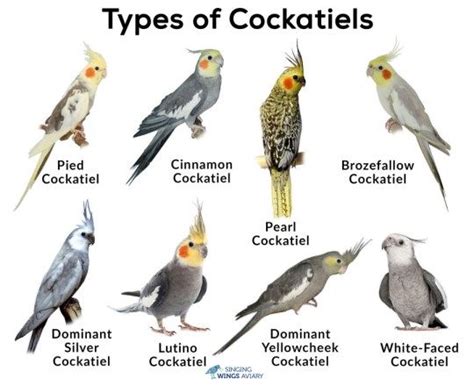Cockatiels are beloved pet birds known for their charming personalities, affectionate nature, and distinctive whistling abilities. Understanding their behavior and characteristics is crucial for providing them with a fulfilling and enriching life.

Physical Characteristics
Cockatiels are medium-sized parrots with a distinctive crest that can be raised or lowered. They typically range in size from 12 to 15 inches in length and weigh between 85 and 140 grams.
- Plumage: Cockatiels have a predominantly gray body with yellow and white markings. The males often have brighter and more vibrant colors, especially around the face and crest.
- Crest: The cockatiel’s crest is a prominent feature that can communicate emotions and intentions. When raised, it can indicate excitement, curiosity, or aggression. When lowered, it can signal relaxation or submission.
- Eyes: Cockatiels have large, black eyes with dark irises. Their eyes provide excellent vision, allowing them to navigate their surroundings effectively.
- Beak: The beak of a cockatiel is short, strong, and slightly curved. It is used for feeding, grooming, and manipulating objects.
Behavioral Characteristics
Cockatiels are highly social creatures that thrive on interaction and companionship.
- Vocalizations: Cockatiels are known for their distinctive whistling abilities. They can produce a wide range of vocalizations, including mimicking human speech and other sounds they hear in their environment.
- Social Behavior: Cockatiels are flock animals and prefer to live in groups. They form strong bonds with their owners and enjoy cuddling, grooming, and playing.
- Intelligence: Cockatiels are intelligent birds that can learn tricks, recognize faces, and solve simple puzzles.
- Motion Patterns: Cockatiels move in a distinctive bobbing motion while walking. They also enjoy hopping and climbing.
Differences Between Males and Females
Male and female cockatiels exhibit some subtle differences in their behavior and appearance:
- Coloration: Male cockatiels typically have brighter yellow markings on their face and crest.
- Vocalizations: Male cockatiels are more likely to whistle and produce complex songs.
- Aggression: Male cockatiels can be more territorial and aggressive towards other birds.
Lifespan and Health
- Lifespan: Cockatiels have an average lifespan of 15-25 years in captivity. With proper care and nutrition, they can live even longer.
- Health Conditions: Cockatiels are generally healthy birds, but they can be susceptible to certain health conditions, such as feather plucking, fatty liver disease, and respiratory infections.
Tips and Tricks for Caring for Cockatiels
- Provide a large cage: Cockatiels need plenty of space to move around and play.
- Offer a variety of toys: Toys can keep cockatiels entertained and mentally stimulated.
- Provide a healthy diet: Cockatiels should be fed a balanced diet of pellets, vegetables, and fruits.
- Keep them socialized: Cockatiels thrive on interaction and companionship. Spend plenty of time with them and provide them with opportunities to interact with other birds.
- Take them to the vet regularly: Regular veterinary checkups can help ensure the health and well-being of your cockatiel.
Reviews
“My cockatiel is the sweetest and most affectionate bird I’ve ever met.” – Sarah J.
“I love listening to my cockatiel’s funny whistling and talking.” – John S.
“Cockatiels are such intelligent and entertaining birds. They bring so much joy to my life.” – Anna M.
“I highly recommend cockatiels as pets for people who want a loving and interactive companion.” – Tom P.
Current Status and the Future
Cockatiels continue to be popular pet birds due to their charming personalities and relatively low maintenance requirements. As research advances, we can expect to learn more about their behavior, health needs, and potential for further domestication.
Conclusion
Understanding the behavior and characteristics of cockatiels is essential for providing them with an optimal environment and ensuring their well-being. By observing their unique traits, fostering their social needs, and caring for them diligently, we can create a fulfilling and enriching life for these captivating and affectionate avian companions.
Additional Information
- According to the American Veterinary Medical Association (AVMA), cockatiels are the third most popular pet bird in the United States.
- Cockatiels have been kept as pets for over 200 years.
- The oldest cockatiel on record lived for 36 years.
- Cockatiels are known for their ability to form strong bonds with their owners and can become very affectionate and playful.
- Cockatiels can learn to talk and whistle a variety of words and phrases.
Tables
Table 1: Physical Characteristics of Cockatiels
| Feature | Description |
|---|---|
| Size | 12-15 inches in length |
| Weight | 85-140 grams |
| Plumage | Gray body with yellow and white markings |
| Crest | Distinctive crest that can be raised or lowered |
| Eyes | Large, black eyes with dark irises |
| Beak | Short, strong, and slightly curved |
Table 2: Behavioral Characteristics of Cockatiels
| Behavior | Description |
|---|---|
| Vocalizations | Distinctive whistling abilities, including mimicking human speech |
| Social Behavior | Flock animals that form strong bonds with their owners |
| Intelligence | Can learn tricks, recognize faces, and solve simple puzzles |
| Motion Patterns | Distinctive bobbing motion while walking |
Table 3: Differences Between Male and Female Cockatiels
| Feature | Male | Female |
|---|---|---|
| Coloration | Brighter yellow markings on face and crest | Subtler yellow markings |
| Vocalizations | More likely to whistle and produce complex songs | Less likely to vocalize |
| Aggression | More territorial and aggressive towards other birds | Less aggressive |
Table 4: Health Considerations for Cockatiels
| Condition | Symptoms | Treatment |
|---|---|---|
| Feather Plucking | Compulsive removal of feathers | Behavioral therapy, environmental enrichment |
| Fatty Liver Disease | Accumulation of fat in the liver | Dietary changes, exercise |
| Respiratory Infections | Sneezing, coughing, difficulty breathing | Antibiotics, veterinary care |





















